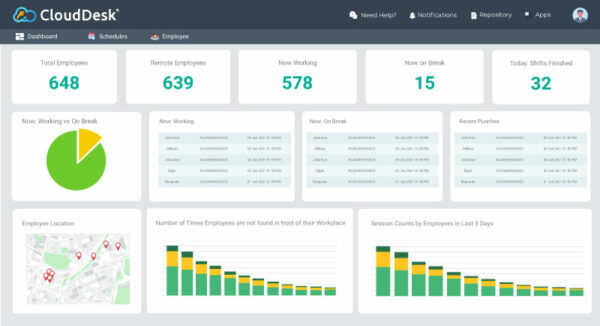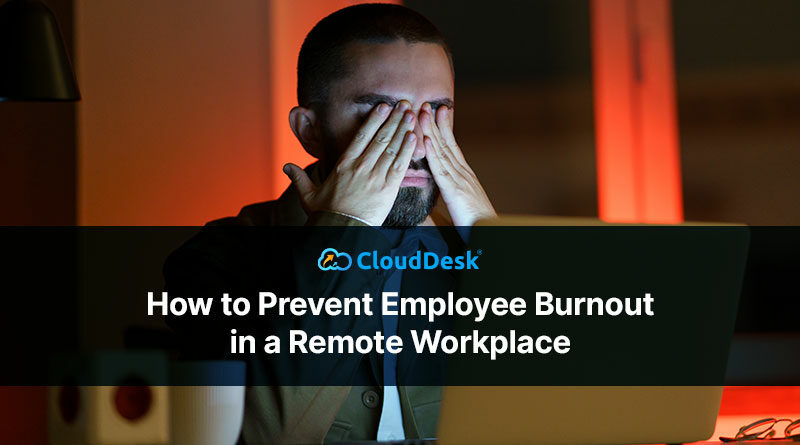How to Prevent Employee Burnout in a Remote Workplace
Both employers and employees have been contending with employee burnout issues for decades. Although the concept is not new, but the on-going pandemic has increased the burnout at work. While remote work also born out of necessity during the pandemic, the continuation of remote work may become the norm due to convenience.
The rapid expansion of remote work has helped employees to enjoy the benefit of working from home. Remote workers say they are more productive, happy, enjoy their flexibility and do not miss their commutes. A recent study from PwC reveals that more than half of the employees they surveyed want to continue working remotely. However, with more employees than ever working from home, the burnout of employees is becoming more evident and a lot more common. Thus prevention of employee burnout has become more important than ever to eliminate any negative impact inside the organization.
What is Remote Employee Burnout?
Both on-site and remote employees can suffer from stressful conditions. On-site employees have to take the hassle of long commutes daily, while remote employees suffer from an unhealthy ‘always available to work’ culture. Remote work is more like a double-edged sword that brings many benefits for employees and on the other hand they have to continuously struggle to prove their efficiency to their manager simply because they are working out of sight.
However, juggling between work and personal life leaves many remote employees with a hybrid headache, where they are unable to nurture a healthy work habit which heightens the state of stress. This also affects their physical and mental well being. As a result, employees are burning out due to prolonged workplace stress that shows up as fatigues, incapability and negativity in the workplace. It slowly affects employees through overload work, lack of managerial support, insufficient feedback and feeling out of the loop on decision-making- which overall fuels the fire and prevents employees from making positive changes. In simple words, employee burnout means lower productivity and higher turnover — especially turnover of your most efficient worker.
How to Recognize Employee Burnout Signs?
Employee disengagement is difficult to identify with remote employees. Remote work environments are not the main cause of employee burnout as they overwhelmingly favor the flexible working approach. Still working flexibly is not eliminating the cause of burnout in remote work environments. Business leaders need to address this issue and implement remote work policies that establish boundaries between work life and home life, encourage transparency, and openness to eliminate the risk of burnout. So managers need to be conscious to determine the warning sign of burnout. Sign of burnout may include:
- Employee who is not getting as much done like before
- Decreased engagement or communication at work
- A change in attitude
- Inability to focus at work
- Increased exhaustion
- Reduced efficiency and productivity
The good news is with the right support and guidance from top management and supervisors, employers can prevent remote employees from burning while working from home.
Key Tips to Prevent Employee Burnout in a Remote Workplace
To help you protect your remote employees and create a happier, healthier, productive virtual workplace, we’ve put together a list of a few ways to support your remote team from anywhere.
- Be Flexible: In a traditional workspace employees have fixed work schedules. They take regular breaks, have a dedicated place to work and a team around them to bounce ideas off. When working from home, the philosophy is much different.
Your employees are managing a lot while working for the organization. They may have to attend to the elderly or children, manage domestic tasks and background noise. They are shuffling home and work responsibility and sitting at a computer to work all day may not be sustainable. Try to be flexible to your remote workers to reduce their burnout. Offer them flexible working hours as much as possible and let them know how you value their effort. Instead of a fixed working hours, let them start to work at their chosen time. If you cannot offer them flexible hours due to work policy, allow them to take multiple breaks whenever it is necessary. This type of flexibility will build trust in your team and can result in a more productive remote workplace. - Schedule Regular Meetings With Remote Teams: Although communication platforms help to keep remote teams together but nothing beats a one-to-one contact. So scheduling individual or team catch-ups is a great way to increase the engagement with your team. It allows you to create a bond with your team and helps them to openly talk to you about their workload or any other issue. You can also directly reach out to them to know their feedback about work and help them recover any issue that impacts their efficiency. Your friendliness, supporting approach is invaluable to bring you closer to your remote employees and help them perform better.

- Implement Data-Driven Remote Employee Productivity Tools: Managing a remote team presents unique challenges which corresponds heavily with the risk of employee burnout in the long run. Implementing the right solution from the beginning is vital to ensure employees productivity and success. Preventing remote workplace issues before they even occur is the best possible strategy and a productivity monitoring software can help you do that effortlessly. In order to monitor and analyze remote employee’s productivity accurately, businesses need a data-driven solution that tracks and monitors internet activity without violating employee privacy. A fully transparent, highly robust remote employee monitoring software allows managers to identify and eliminate the risk of employee burnout in a proactive way.
- Respect work-life boundaries: Remote employees work and live in one space, it is harder for them to not think that they are living at work. This clearly suggests that remote employees don’t feel like they have clear boundaries between work life and their personal life, which can lead to unclear expectations and imbalance in work-life. Managers have to work together to establish clear rules about remote work policy to help employees establish boundaries between work and personal time. Once your employees are done with the day, do not knock them for any additional task unless it is extremely important.
- Appropriate workloads: When you are assigning tasks to your remote employees make sure you are assigning a reasonable amount. If you identify any employee being overloaded with work, reach out to them and distribute their work with someone who is comparatively doing less. By removing workload you are actually eliminating stress that leads to burnout.
- Create a Positive Team Culture: Think out of the box to create a positive team culture in your remote environment. Just because you are working online doesn’t mean you can’t celebrate birthday, business success or after-work coffee virtually.
- Streamline your Workflow: Organize your workflow to make it easier for remote employees to work. As a result you can remove unwanted stress from your team and help them work as efficiently as possible. Empower your remote team with the right tool and help them cope with their workloads.
Final thoughts
According to Forbes remote employees are 35%-45% more productive, and their output also increases by about 4%. To manage your remote team and to reduce the risk of burnout you have to learn how to support them and keep them motivated. As we have already mentioned in this article, you can try these steps to look after your employees to help them stay productive and keep the business running smoothly. Flexible work policy, good communication, advanced tools, right support and transparency can make your business achieve the highest success.
CloudDesk is a highly robust employee monitoring software that you can use to keep your employees productive and also to detect early signs of burnout. CloudDesk is an affordable and effective software that keeps an eye on employee activity and helps you to better understand their efficiency. Signup for a FREE 14 Day Trial Offer to try CloudDesk account today to see how it works.












